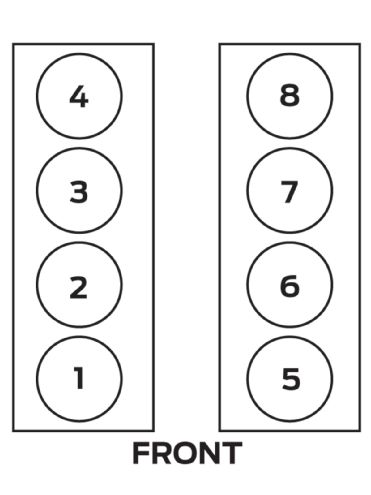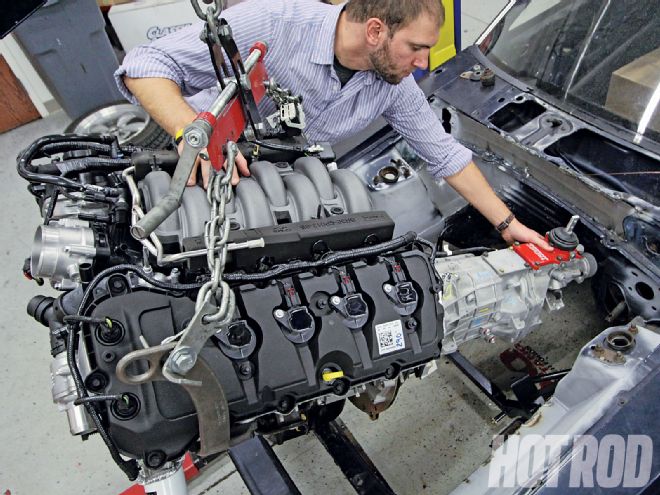
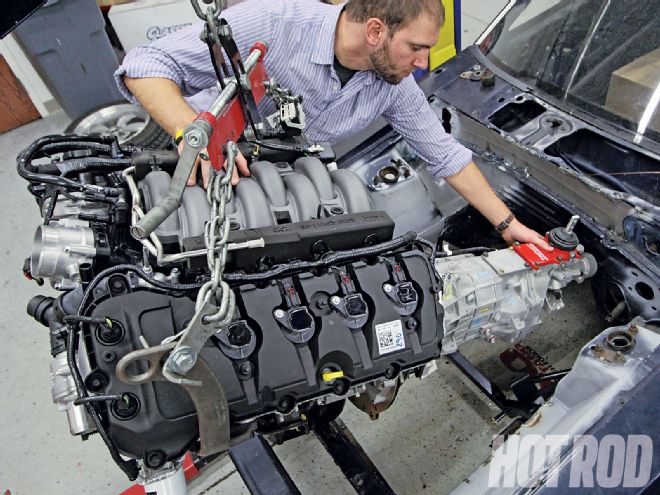 Coyote-engine/Fox-body hybrids are among the most popular retrofits. This 5.0L's being dropped into an '85 Mustang LX owned by Evan J. Smith, editor of our sister publication Muscle Mustangs & Fast Fords. You can read all about the ongoing project in that mag's print editions or online at MuscleMustangFastFords.com. The ultimate goal is a superlight, road course–capable street car that should make 420–425 rwhp with Ford's Boss intake, long-tube headers, and a T56 trans.
Coyote-engine/Fox-body hybrids are among the most popular retrofits. This 5.0L's being dropped into an '85 Mustang LX owned by Evan J. Smith, editor of our sister publication Muscle Mustangs & Fast Fords. You can read all about the ongoing project in that mag's print editions or online at MuscleMustangFastFords.com. The ultimate goal is a superlight, road course–capable street car that should make 420–425 rwhp with Ford's Boss intake, long-tube headers, and a T56 trans.
Unless you've been cast away on a desert island, you're aware that Ford's current performance standard-bearer is the '11-and-later Mustang TI-VCT (Twin Independent, Variable Camshaft Timing) 5.0L V8 that's commonly called the Coyote. The 412hp engine is currently the standard Mustang V8—no more SOHC two- or three-valve base motors. Before long, the new 5.0Ls will be all over the wrecking yards, but in the meantime, Ford Racing Performance Parts (FRPP) and savvy aftermarket companies are already full speed ahead. Not only does FRPP offer a bunch of crate engines—including supercharged and high-output versions—but it also has a range of add-on kits to simplify retrofitment. And what Ford doesn't have, the aftermarket does—or soon will.
But hasn't the modular-engine architecture been around since the mid-'90s? Yes, but the new TI-VCTs have a bunch of changes that collectively yield significant differences from previous modular motors. Although the bellhousing bolt pattern and engine-mount pattern are still the same, just about everything else is different, not only in physical attributes but also in the electronics department. And it's the electronic-integration portion that's often the most challenging part.
That hasn't fazed early pathfinders, though. With the help of these hardy pioneers as well as official FRPP and other aftermarket sources, we present a broad overview on the basics of retrofitting the TI-VCT engine into older cars. Next month, we'll show some real-world examples of cars with completed Coyote swaps.
Physical Fitness
The most daunting problem with a Coyote swap is the engine's physical size. The massive cylinder-head width is an obstacle to swaps into classic Ford muscle cars with their high-mounted shock towers, which make for a narrow engine bay. There's virtually no chance of squeezing a Coyote into a stock early Falcon or '65–'66 Mustang engine bay, but it may be possible to notch the shock towers on the later, wider cars, retaining a basically stock front end but with coilover shocks or struts.
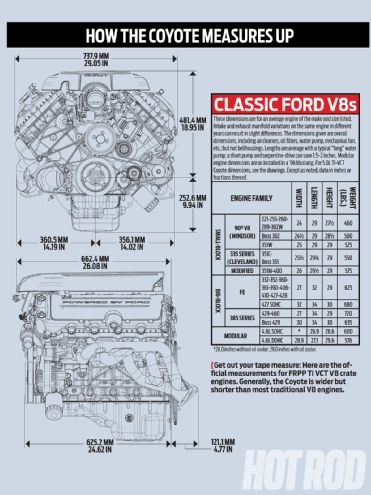
But let's face it: That old suspension pretty much sucks, even if it isn't already worn out. Everyone wants massive, modern disc brakes, and the old steering boxes are about as slow as molasses. The best bet is axing the entire front end for an aftermarket subframe that includes modern suspension, brakes, and rack-and-pinion steering. Heidts, Rod & Custom Motorsports, Fatman Fabrication, Total Cost Involved (TCI Engineering), Detroit Speed, and others all sell high-shock-tower-Ford conversion clips that can accommodate modular engines with their factory oil pans.
Oil Pan and Filter
Yes, that's the other major problem an entire replacement front-end resolves: oil-pan sump clearance. The '60s cars all used front-sump oil pans, and the Coyote uses a rear-sump pan that won't clear old chassis. The TI-VCT engine's oil pan is different from—and won't interchange with—earlier modular motors because of front-cover changes as well as the relocation of the ignition's tone ring (aka the crank trigger wheel) from the front to the rear of the crank.
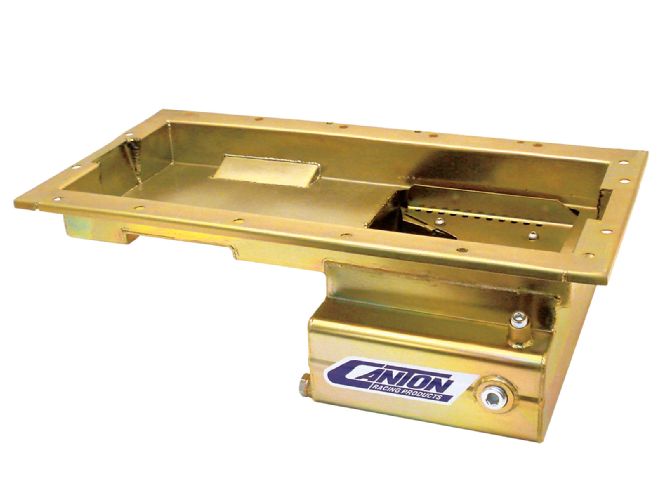 Canton's Coyote front-sump oil pan (PN 15-738) fits stock muscle car–era Ford chassis (assuming you can get the engine itself to clear the shock towers). The T-sump design offers extra capacity yet provides good ground clearance for lowered road-race applications. Use it with Canton's matching pickup (PN 15-739).
Canton's Coyote front-sump oil pan (PN 15-738) fits stock muscle car–era Ford chassis (assuming you can get the engine itself to clear the shock towers). The T-sump design offers extra capacity yet provides good ground clearance for lowered road-race applications. Use it with Canton's matching pickup (PN 15-739).
If you need more oil control than the stocker provides, FRPP sells the factory Boss 302 oil pan (M-6675-M508) with added baffles, as well as a full-on race pan (M-6675-M50BR) from its Grand Am Racing program. You also have a choice of aftermarket pans from Canton, Champ, and Moroso.
The stock oil filter sticks out of the driver side of the block at about a 45-degree angle and may not clear all chassis. One option is using a shorter, nonstock filter with similar threads and characteristics. The standard Coyote's Motorcraft filter (FL500S) has M22x1.5 metric threads and is 4.09 inches long with a 3-inch od. There is an ACDelco filter (PN PF48) used on many LS-powered GM cars and trucks with otherwise similar dimensions, and it's about ½-inch shorter.
Not enough? FRPP sells a modular-engine, 90-degree oil-filter adaptor (PN M-6880-M22) that tucks the filter housing tight against the side of the block while accepting a larger-capacity Motorcraft FL1A filter. If necessary to completely remote-mount the filter, use FRPP's oil filter adapter (PN M-6881-M50) that fits '11–'13 5.0L 4V TI-VCT aluminum block engines and is machined with O-ring female bosses for AN –10 fittings. If you want an easy-to-install, sandwich-style, water-to-oil type of cooler, FRPP's PN M-6642-MB was used OE on the '12 Mustang Boss 302.
What Interchanges? Which previous-generation Ford Modular engine parts fit the new TI-VCT 5.0L "Coyote" Engine? Part Type Will It Fit? Bellhousing or bellhousing bolt pattern Yes Exhaust headers or manifolds No Flywheel or flexplate Maybe* Front accessory brackets/drives No Front cover No Intake manifolds No Motor mounts Yes Oil pans and pickups No Powertrain Control Module (PCM) No Throttle-bodies No Water pump No *Must be for 8-bolt (DOHC) crank; verify tone-ring clearance and crank offset.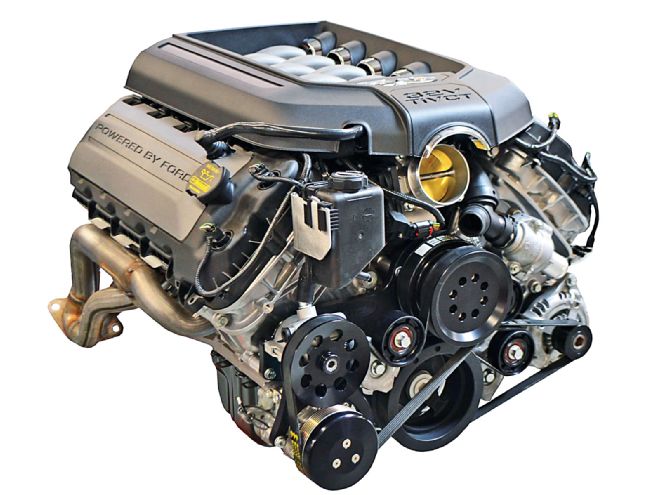 One solution for running a hydraulic power-steering pump and an alternator while still retaining the A/C compressor is Turn Key Engines's Road Runner drive system that mounts a PSC power-steering pump, a Sanden SD7 A/C compressor, and a FRPP or OE alternator. It even works with FRPP's supercharger kit.
One solution for running a hydraulic power-steering pump and an alternator while still retaining the A/C compressor is Turn Key Engines's Road Runner drive system that mounts a PSC power-steering pump, a Sanden SD7 A/C compressor, and a FRPP or OE alternator. It even works with FRPP's supercharger kit.
Accessory Drives
Out of the box, most FRPP crate engines have only the crank and water-pump pulleys installed. The exception is the just-announced Aluminator XS engine (PN M-6007-A50XS), which does come with an alternator. A Coyote engine's front accessory drives and mounting brackets are different from those on earlier modular motors. The earlier stuff won't fit because the front cover is different—but the new front accessory drive may not play well in older cars. The big hurdle: '11-up Mustang GTs have electric power steering, meaning the stock setup lacks provisions for mounting a hydraulic power-steering pump. The good news is that the A/C compressor is now on its own belt and located low on the engine's right side. That makes it easier to delete the A/C drive provisions on a retrofit application, plus the vacated space leaves a natural place to either relocate the alternator from the left side or to mount a hydraulic power-steering pump. FRPP's Boss 302R 5.0L power-steering pump bracket (PN M-8511-M50BR) can be installed in place of the OE A/C compressor and mounts an '05–'10 Mustang GT power-steering pump. FRPP also offers a Boss 302 alternator kit (PN M-8600-M560BALT) that includes the high-rpm Boss 302 alternator, higher-tension belt-tensioner, larger pulley, the correct-length belt, and mounting hardware. Turn Key Engines, Vintage Air, KRC, and March Performance offer complete aftermarket accessory-drive solutions.
Exhaust
Stock and FRPP 5.0L Coyotes come with tubular headers, but they're designed for the late-model Mustang and may not fit earlier applications. Earlier modular-engine exhausts—whether for SOHC or DOHC engines—won't fit the TI-VCT cylinder heads. For street rods, FRPP offers cast manifolds (PN M-9430-SR50) that are basically the same as the production TI-VCT 5.0L truck F-150 manifolds. Shorty headers are available from JBA; although listed for production Coyote Mustangs, they may back-fit into some earlier cars. Several dedicated header configurations for Ford Fox-body retrofits are available from BBK and Kooks. These will require either an aftermarket front K-member compatible with the Modular motor and its engine mounts or a '96–'04 Ford Mustang SN95-chassis, 4.6L Cobra crossmember that's been modified to fit the '78–'93 Fox-bodies. (Swapping in the older 4.6L DOHC engine into a Fox-body was covered in the article "Ford 4.6L DOHC Into Fox Body," Aug. '07; also available online at HotRod.com. Many of the tips are applicable to the Coyote motor as well.)
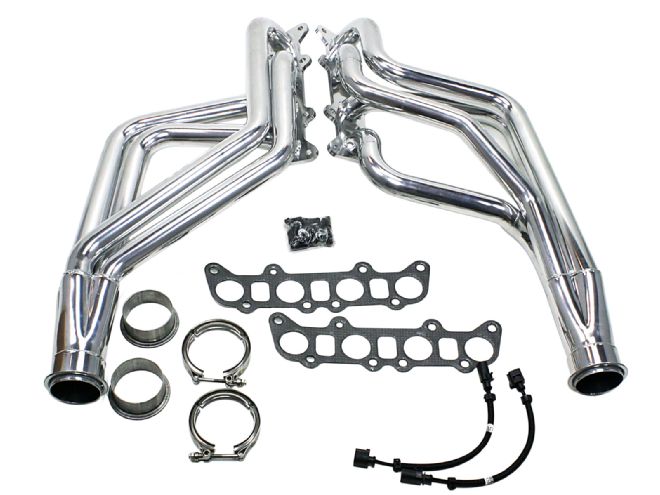 Doug's Headers makes Coyote long-tube headers (PN D6651, coated; D6651R, uncoated) that fit the Total Cost Involved and similar classic Ford muscle-car conversion front clips.
Doug's Headers makes Coyote long-tube headers (PN D6651, coated; D6651R, uncoated) that fit the Total Cost Involved and similar classic Ford muscle-car conversion front clips.
Cooling
The cooling system is conventional (not reverse-flow), but the inline, remote thermostat also contains the coolant bypass (i.e. inlet and outlet main hoses both route through the thermostat, not directly to the engine). The coolant fill-cap must be the highest point in the system. If it isn't (as is the case on current Mustang production cars), a separate, remote-mounted surge or supply tank is mandatory to properly purge the engine of air bubbles. To allow purging air from the right-hand cylinder head as well as provide sufficient coolant flow through that head when not running a heater, the heater supply and return hoses must be spliced together, and a 5/16-inch-diameter restrictor needs to be inserted into the hose assembly. Ford's installation instructions contain a detailed layout. Electric fans are mandatory because the water pump has no provisions for supporting a mechanical fan.
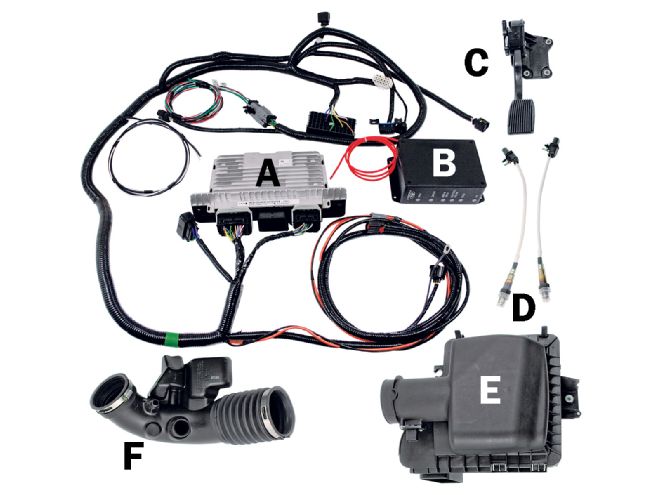 FRPP's Control Pack (PN M-6017-A504V) makes it easy to wire in a retrofit 5.0L 4V TI-VCT motor. Besides the harness, major parts include the PCM (A), power-distribution module (B), mandatory electronic pedal (C), O2 sensors (D), airbox with MAF sensor (E), and inlet tube (F).
FRPP's Control Pack (PN M-6017-A504V) makes it easy to wire in a retrofit 5.0L 4V TI-VCT motor. Besides the harness, major parts include the PCM (A), power-distribution module (B), mandatory electronic pedal (C), O2 sensors (D), airbox with MAF sensor (E), and inlet tube (F).
Electronics
Right now, virtually no one is using a wrecking-yard setup, for several reasons: The stock vehicle antitheft system is hard to defeat, the stock Powertrain Control Module (PCM, aka "the computer") ties into other systems not usually found on a retrofit application, and it's hard to deal with the stock returnless fuel system. The problem-solver here is FRPP's Control Pack. As Ford tuner, racing, and performance shop owner Justin Burcham of JPC Racing explains, "We prefer the FRPP Control Module solution. You could salvage parts from a wrecking yard, but it's a lot of hassle, and not worth the extra time or money. The FRPP harness is a plug-and-play with instructions. Everything is clearly labeled and easy to install."
The $1,500 (give-or-take) Control Pack utilizes a central-power distribution box that contains all relays needed for the engine, A/C, and cooling-fan controls. Besides simplified wiring hookup and all necessary sensors, the kit includes a factory PCM that's calibrated for an unmodified, naturally aspirated 5.0L Mustang with a manual transmission, yet can still be diagnosed or reprogrammed, thanks to its standard OBD-II diagnostic plug.
The retrofit harness will convert the stock returnless fuel-supply system to a conventional return style that's much easier to integrate in a custom application. However, use of the modern, drive-by-wire electronic pedal is mandatory (it's included in the box). The good news is you won't need to worry about throttle linkage; the bad news is it may be necessary to fabricate an adapter bracket to bolt the pedal into an earlier car.
Required for correct operation and also included in Ford's kit is an '11–'13 Mustang airbox and inlet assembly. Unfortunately, the bulky unit is hard to package in many retrofit applications. If it won't fit, and you need to fab your own inlet solution, Ford's recommended length, curvature, and cross-sectional recommendations must be followed or it will throw off the MAF (mass airflow) sensor, requiring PCM recalibration. Aftermarket inlet schemes will almost certainly require recalibration as well. Ditto for most engine mods, or if using the higher-performance Ford crate engines—either the Boss 302 racing mill, the Alumintor XS, or the low-compession 5.0L crate mill intended for use with a supercharger.
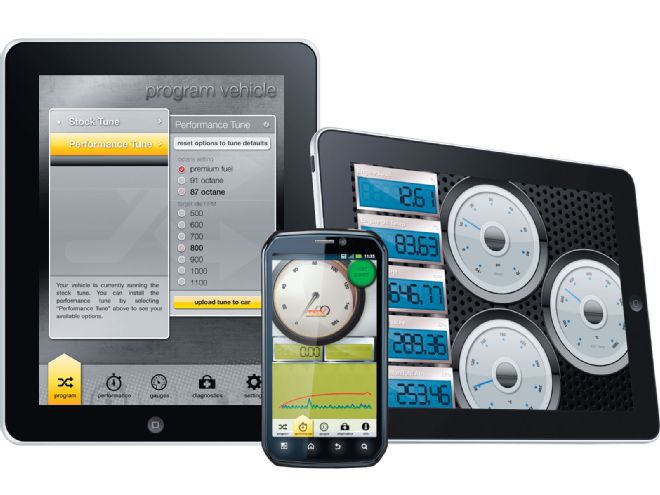 Need to reflash? SCT handheld tuners can download new custom tunes or allow end users to perform their own mods. They can also connect to a laptop running SCT software to allow modding just about any aspect of a Ford PCM. The latest wrinkles are plug-in programming iTSX/TSX Apps for tablets and smartphones, including Androids, iPhones, and iPads.
Need to reflash? SCT handheld tuners can download new custom tunes or allow end users to perform their own mods. They can also connect to a laptop running SCT software to allow modding just about any aspect of a Ford PCM. The latest wrinkles are plug-in programming iTSX/TSX Apps for tablets and smartphones, including Androids, iPhones, and iPads.
If it's necessary to reprogram the PCM to deal with performance mods, air-inlet duct calibration, or driveability issues, SCT Performance and DiabloSport are two sources for reprogramming tuners and software. One thing they still can't do, though, is defeat the production TI-VCT engine PCM's vehicle antitheft system. The difficulty is that bypassing the antitheft protection on a late-model Ford requires modifying the PCM's internal hardware; it's not just a software reflash! SCT is said to be working on the problem and may have a solution by the time you read this. According to SCT's Jeff Johnson, "This will require physical PCM disassembly, so when we're ready to go on this, you'll have to mail the PCM to us for modification."
Outside the Ford sandbox, stand-alone, Coyote-compatible EFI systems are available from FAST (better for primarily street setups) or Big Stuff (probably better for racing). Mainstream EFI systems like these still won't support variable valve timing, so the cams must be locked in place. Retaining the engine's independent variable cam timing with an aftermarket EFI controller requires a pricey high-end system and advanced programming know-how. Presently, AEM, DTA, MoTeC, and Autronics are said to support variable cam timing.
Ford Racing 5.0L TI-VCT Crate Engine Lineup Crate Engine Package Description Part No. Cr Crank Connecting Rods Pistons Oil Pan Top Cover¹ Price source² Price³ 5.0L 4V TI-VCT 412HP Mustang Crate Engine (412 hp/390 lb-ft) M-6007-M50 11.0:1 Forged Forged I-beam Hypereutectic 8 qt No SRE $6,119.95 Coyote Sealed Racing Engine (NMRA Coyote Stock Class Spec motor)4 M-6007-M50S 11.0:1 Forged Forged I-beam Hypereutectic 8 qt No SRE $6,129.95 5.0L DOHC Aluminator Crate Engine (naturally aspirated) M-6007-A50NA 11.0:1 Forged Forged Manley H-beam, ARP2000 bolts, Boss 302 rod bearings Mahle forged 8 qt Yes FRPD $8,050.00 5.0L DOHC Aluminator Crate Engine (supercharged applications)5, 6 M-6007-A50SC 9.5:1 Forged Forged Manley H-beam, ARP2000 bolts, Boss 302 rod bearings Mahle forged 8 qt Yes FRPD $8,350.00 5.0L TI-VCT 4V Boss 302S Engine Assembly 5, 7 M-6007-M50BR 11.0:1 Forged Upgraded sintered-forged I-beam Forged 12 qt Yes SRE $13,249.00 5.0L DOHC Aluminator XS Crate Engine (500-plus hp) 5, 8 M-6007-A50XS 11.5:1 Forged Forged Manley H-beam, ARP2000 bolts, Boss 302 rod bearings Mahle forged 12 qt (Note 9) RYPP $14,449.00NOTES: ¹Engines with no top cover, use cover kit PN M-9680-M50. ²FRPD = Ford Racing Parts Direct; RYPP = Roush Yates Performance Parts; SRE = Summit Racing Equipment. ³Priced Feb. '13 and subject to change; does not include any taxes or shipping charges. 4For racing, no warranty; otherwise identical to M-6007-M50. 5Custom PCM tuning required for optimum performance. 6Does not include supercharger; supercharger kits sold seperately. 7Includes CNC-ported heads with sodium-filled valves and high-rpm, short-runner intake. 8Includes fully-ported Boss heads, high-perf cams, and alternator. 9Not applicable: This engine assembly includes a short-runner Cobra Jet intake manifold.
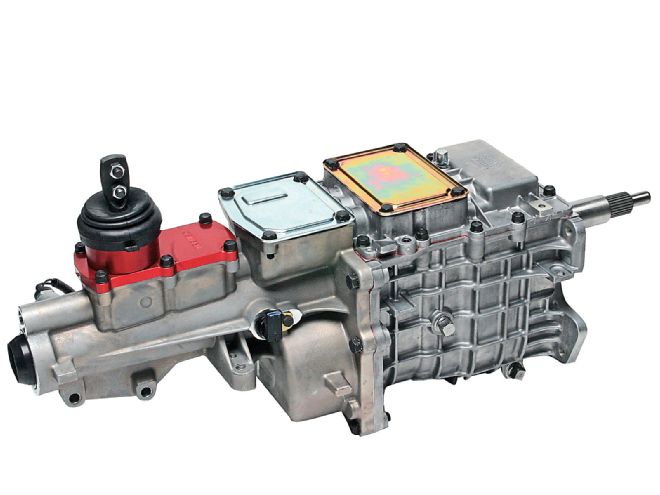 The two most popular manual trannies being used are either the T56/6060 six-speed or a Tremec five-speed TKO/3550 (shown). The latest T56 Magnums are rated at 700 lb-ft, compared with about 600 lb-ft for the latest 3550s. The 3550 is a little slimmer and lighter, so it may be an easier fit in old muscle cars. D&D, Fortes, Hurst Driveline, and Keisler offer Tremec-based swap kits.
The two most popular manual trannies being used are either the T56/6060 six-speed or a Tremec five-speed TKO/3550 (shown). The latest T56 Magnums are rated at 700 lb-ft, compared with about 600 lb-ft for the latest 3550s. The 3550 is a little slimmer and lighter, so it may be an easier fit in old muscle cars. D&D, Fortes, Hurst Driveline, and Keisler offer Tremec-based swap kits.
Drivetrain Interface
Like all modular engines, the 5.0L is neutral-balanced. Also, like previous DOHC Modular family members, the 5.0L has an eight-bolt crank flange—so it will accept existing modular eight-bolt flywheels and flexplates (but not six-bolt-crank SOHC Modular motor parts). Some sources maintain that the Coyote's crank offset out the back of the block is 4mm (0.167-inch) greater than previous modular engines to accommodate the rear-mounted tone wheel, but early adapters have not reported any interchange issues with existing manual-transmission hardware; there seems to be enough leeway in the clutch linkage to accommodate the slight difference. On an automatic, there's a chance that the greater offset could result in the converter bottoming against the front pump, causing possible trans or converter damage. FRPP's M-6373-A engine plate will usually add just enough extra clearance if this is encountered. Such plates can also help to correct starter tooth-engagement problems.
Although it's possible to use the automatic transmissions that come stock behind a 5.0L, at this point it would require an auto-trans-compatible production PCM and a takeout harness. That's because the FRPP's controller and wire harness designed for a manual transmission won't support an automatic trans that would otherwise interface with the engine PCM and for which no separate aftermarket stand-alone control unit is offered. SCT programmers support six-speed automatic recalibration on stock production PCMs, but with a retrofit, there's still that pesky antitheft-defeat issue.
For the moment, that leaves older automatics as the only practical choice. The popular conversions so far have been either beefed-up C4 three-speeds or the AOD/AODE/4R70W four-speed family. Performance Automatic's old-school C4 trans kits range from a mild, street rod–level package to full-race, drag-only packages capable of supporting up to 1,000 hp.
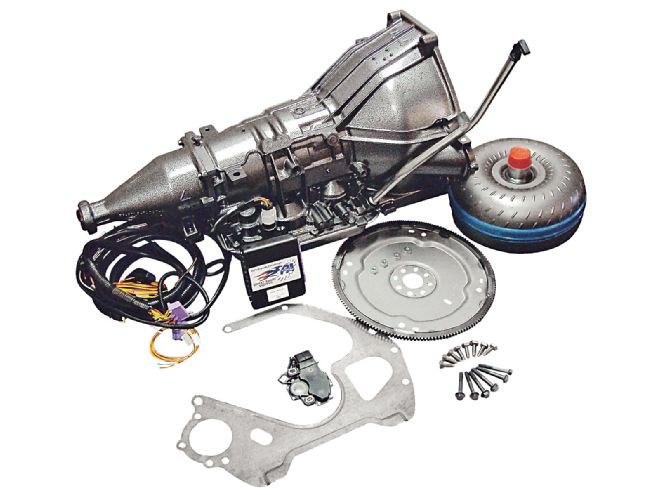 A popular street automatic-trans solution is Performance Automatic's Street Smart 4R70W package, which includes its Smart Shift stand-alone trans controller, a custom torque converter, a dipstick/filler tube, a trans wiring harness, a block-plate, a compatible 5.0L TI-VCT flexplate, and all necessary hardware. It's good to 650 hp and has a lifetime warranty.
A popular street automatic-trans solution is Performance Automatic's Street Smart 4R70W package, which includes its Smart Shift stand-alone trans controller, a custom torque converter, a dipstick/filler tube, a trans wiring harness, a block-plate, a compatible 5.0L TI-VCT flexplate, and all necessary hardware. It's good to 650 hp and has a lifetime warranty.
As for manual transmissions, forget about a T5—it's just not strong enough. The general preference for retrofits is either Ford-style Tremec heavy-duty five-speed transmissions (such as the TKO, TR-3550, and other family members) or Tremec T56/6060-family six-speed transmissions. To bolt aftermarket-style, retrofit Ford-style T56 transmissions like those offered by FRPP and aftermarket transmission shops into a modular motor (including the 5.0L), use Quicktime bellhousing PN RM-8080. To bolt up Tremec heavy-duty five-speed transmissions, use FRPP bellhousing PN M-6392-M46 and starter index plate M-7007-A. These bellhousings are really designed for older-style mechanical or cable-clutch linkage, but if you don't want to mess with mechanical linkage, McLeod offers bolt-on or slip-on hydraulic clutch release bearings that can be used with conventional bellhousings. If you need a solution for other, even non-Ford, manual transmissions, Quicktime offers many weird adaption bellhousings. There's also McLeod's unique modular bellhousing system that can be stacked together to accommodate just about any manual trans.
What's It Gonna Cost?
It's amazing that there's already so much support for the TI-VCT engines, but let's not kid ourselves—late-model, high-tech performance doesn't come cheap. As Kurgan Motorsports' Wade McGowan explains,"Ford Racing really hit the nail on the head with their support for swapping these engines. The downside right now is cost. With the engine and all the other stuff you're going to need, you will probably have $12,000–$14,000 in the car. Right now, wrecking yard pricing is still close to the new price." This assumes starting with one of the lower-priced crate engines, then doing most of the work yourself. Farming the whole job out, plus adding a whole new front end, suspension, braking, and steering system, could push the cost into the $20,000 range. Still, you've got to climb up on the horse sometime, and those hardy pioneers are breaking the ice for the not-too-distant day when engines will become more plentiful in the wrecking yard. Next month, we'll turn theory into reality, as we take a look at actual swaps in a variety of early- and late-model vehicles.
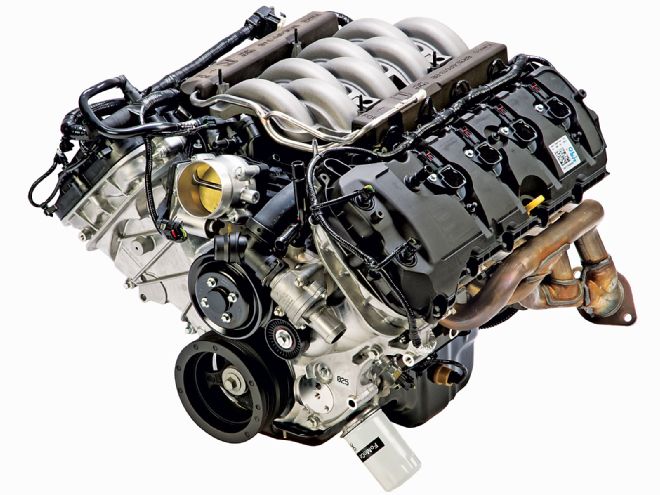 If you shop around, a new 412hp FRPP 5.0L 4V TI-VCT crate engine like this can be yours for less than $6,200. Note that the engine has no accessories (just a crank and water-pump pulley) and no top cover. You'll also probably need to grab some of the fuel and coolant plumbing out of the wrecking yard or fabricate your own.
If you shop around, a new 412hp FRPP 5.0L 4V TI-VCT crate engine like this can be yours for less than $6,200. Note that the engine has no accessories (just a crank and water-pump pulley) and no top cover. You'll also probably need to grab some of the fuel and coolant plumbing out of the wrecking yard or fabricate your own.
If the Stock Airbox Won't Fit
FRPP says the air cleaner assembly (aka "airbox") with its integral mass airflow (MAF) sensor must be used as received or it will screw up the PCM calibration. Unfortunately, it doesn't package well in many retrofit installs. If you need to modify the supplied airbox or fab your own inlet system, Ford offers the following guidelines for proper MAF-sensor location. Even if the PCM still needs recalibration, adhering to these recommendations should result in optimum system performance.
If the Engine Stalls Under Deceleration
A small number of early adopters using the Ford conversion harness kit have experienced an engine-stall condition during or immediately after hard deceleration. There are at least two workarounds for this problem. Just like a standard Ford production PCM, FRPP's retrofit unit includes full support for a VSS (vehicle speed sensor), but the wires are not included in the retrofit harness. A VSS lets the PCM sense that the vehicle is moving (or not). Most modern transmissions (including popular aftermarket replacements) have VSS sensor provisions. FRPP's provisional workaround is adapting its existing Speed-Dial unit (PN M-4209ADPT-AC) that's officially listed in the catalog as an electronic-speedometer recalibration tool, but it now serves as a hardware patch for interfacing a VSS to FRPP's PCM.
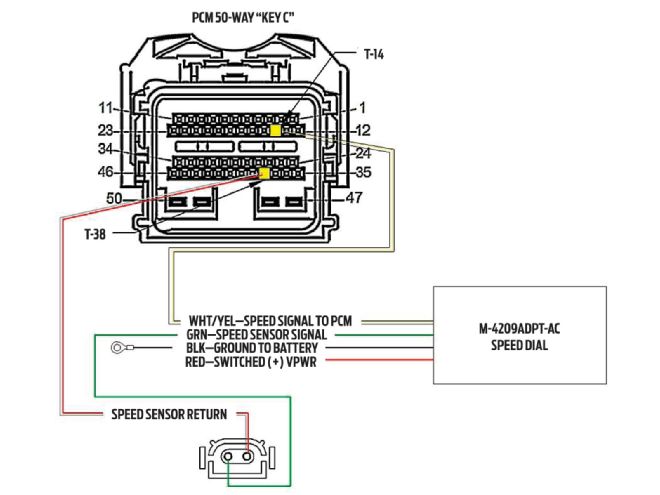 Here's how to wire in the FRPP Speed-Dial to serve as a VSS patch device on its conversion PCM. Two of the four wires from the Speed-Dial need to be added to the PCM's current
Here's how to wire in the FRPP Speed-Dial to serve as a VSS patch device on its conversion PCM. Two of the four wires from the Speed-Dial need to be added to the PCM's current
The other solution is a custom software download from JMS Chip and Performance, an authorized SCT distributor and custom tuner. It's available for purchase and download for those who own SCT's tuning devices. The entirely software-based solution is said to eliminate the stalling condition without the need to add a VSS or a piggyback device.
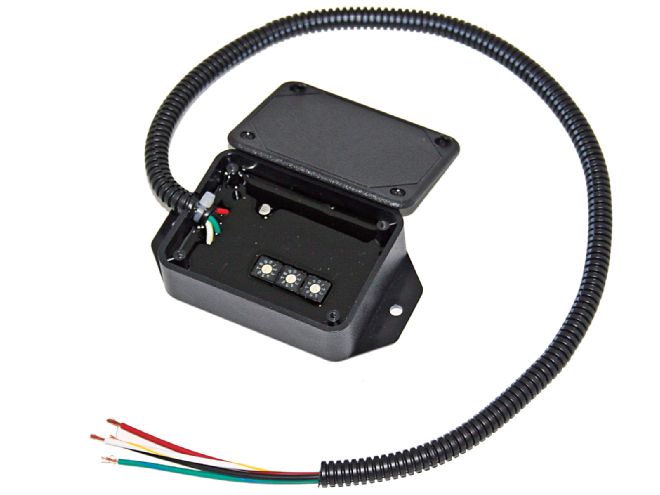 As used to just cure the deceleration issue, the Ford Speed Dial doesn't care about what the VSS switch's pulse/mile sampling rate is—so just set all the dip-switch dials to
As used to just cure the deceleration issue, the Ford Speed Dial doesn't care about what the VSS switch's pulse/mile sampling rate is—so just set all the dip-switch dials to
If the Oxygen Sensors Must be Moved
FRPP's engine harness and controls package supplies two wide-band oxygen sensors that are designed to mount in the stock '10–'11 Mustang GT locations. If the factory headers don't fit your old chassis, the relative sensor position may need to change on any new exhaust. If that's the case, position each sensor so it can sample from all four cylinders on one bank (for example, in the header collector). Ford also frowns on altering sensor wire lengths, claiming that such alterations can degrade sensor function. If the headers won't permit sampling all four cylinders without harness mods, Ford says the least harmful alternative is locating the sensors to sample one cylinder per bank: "The cylinders that have on average the closest air/fuel ratio to the bank average are cylinder No. 4 on Bank 1 and cylinder No. 7 on Bank 2; the next best choices are No. 3 and No. 8."
